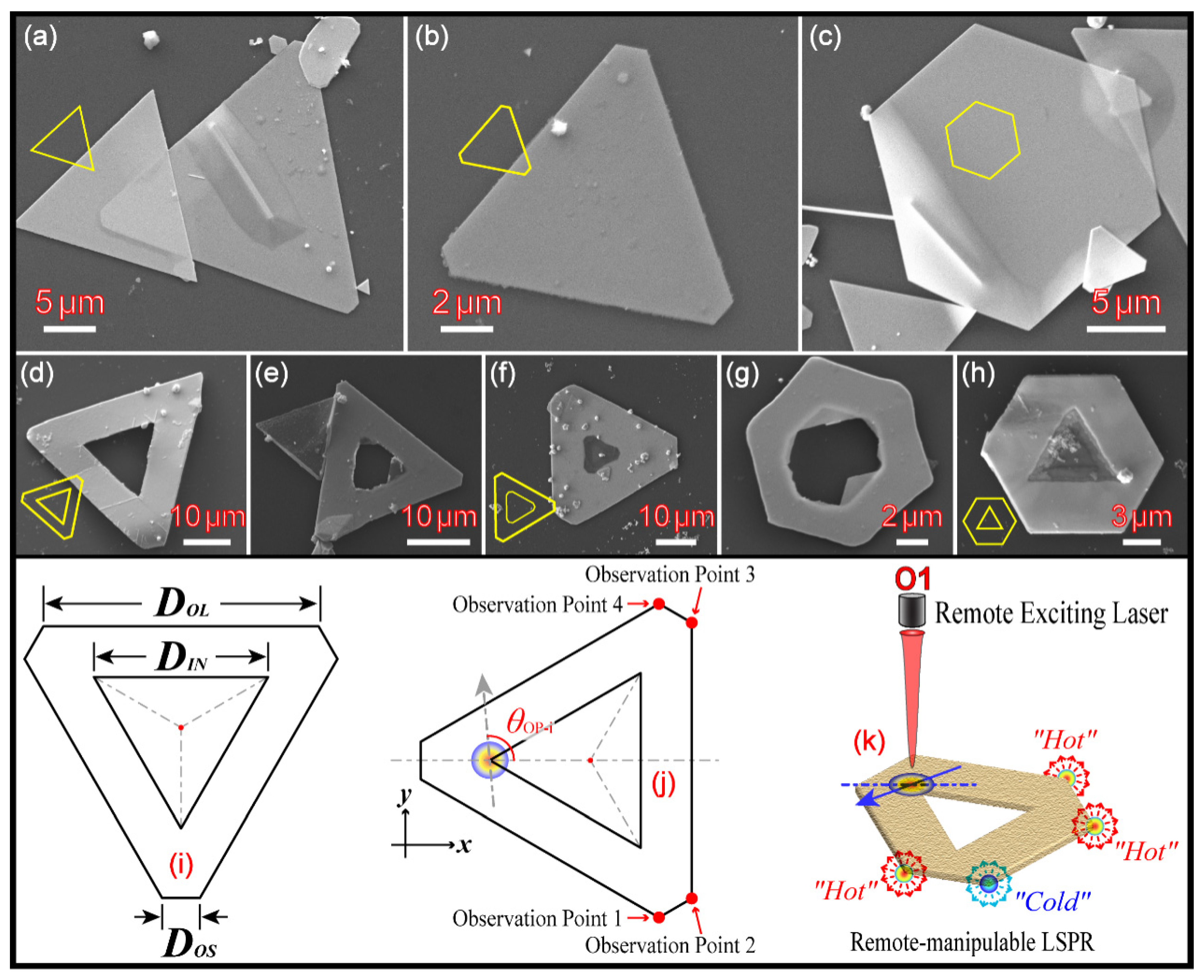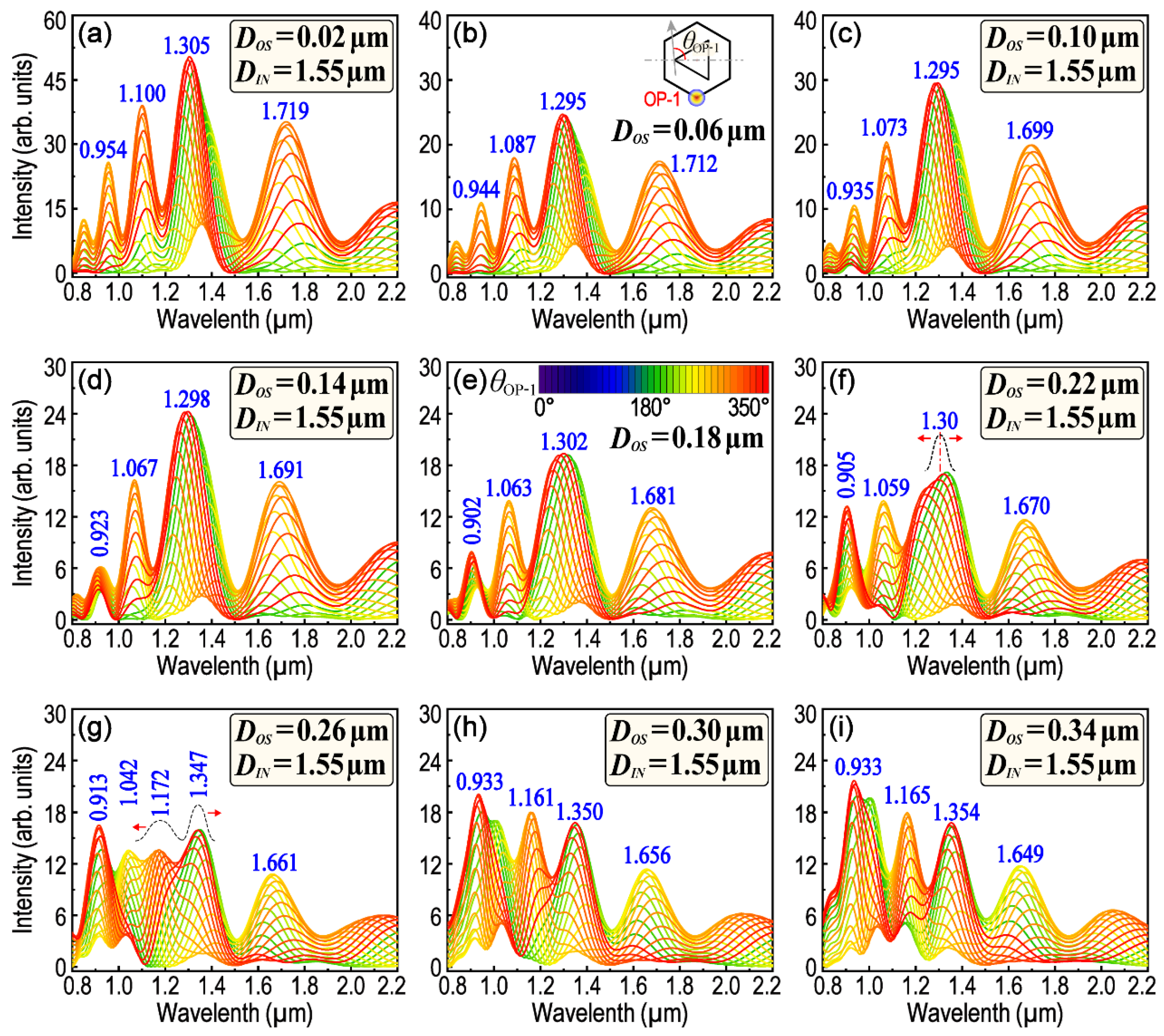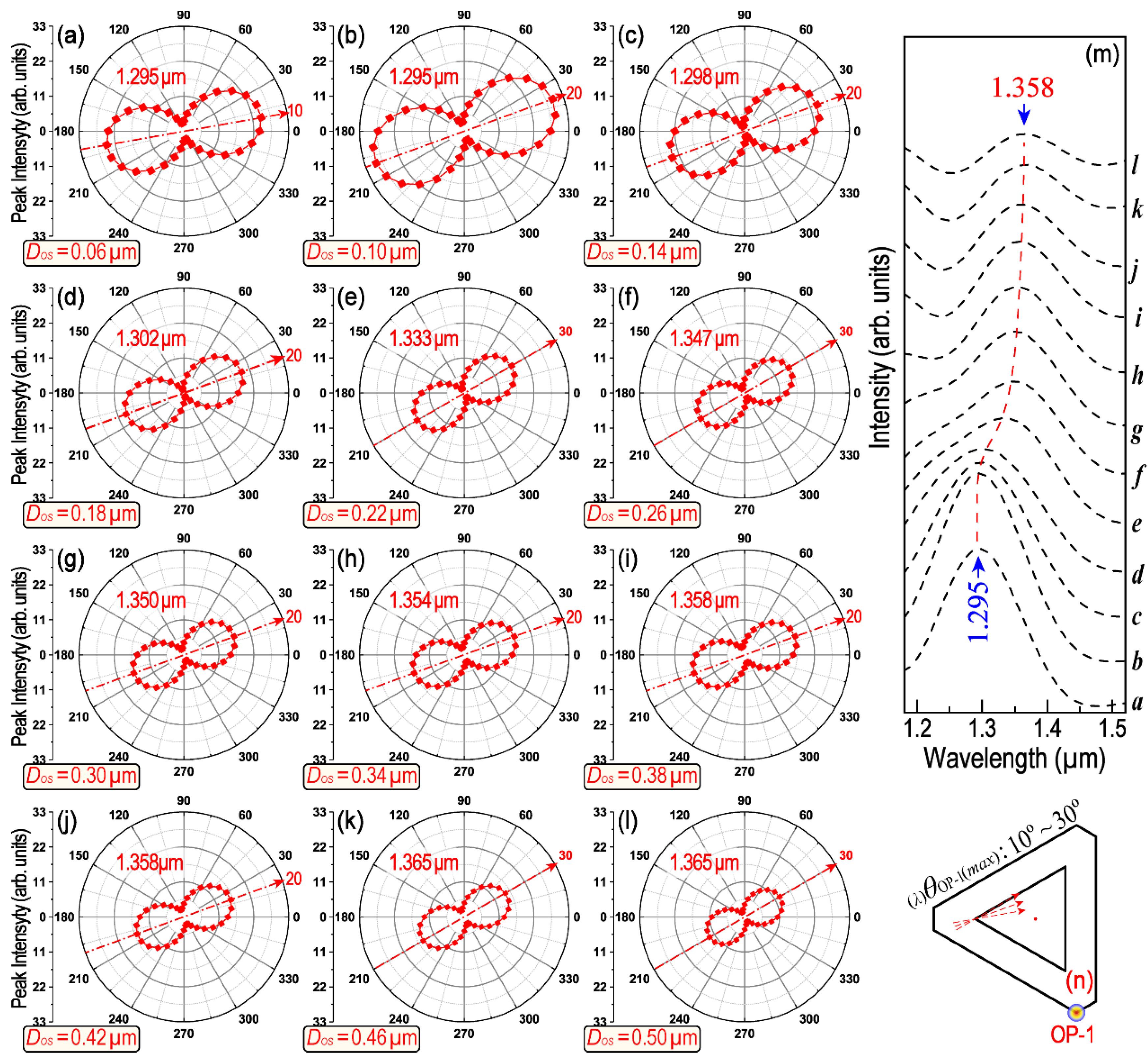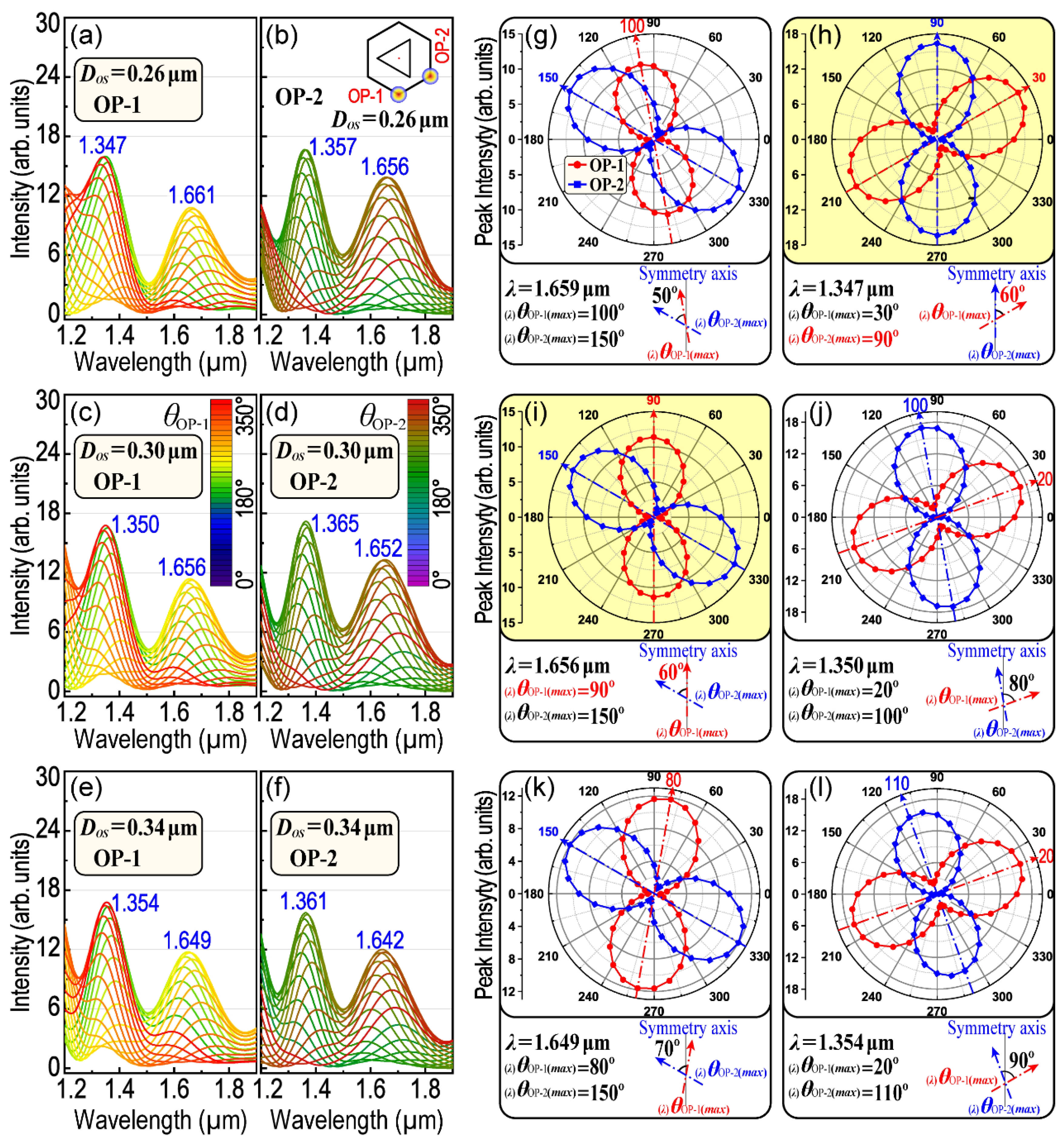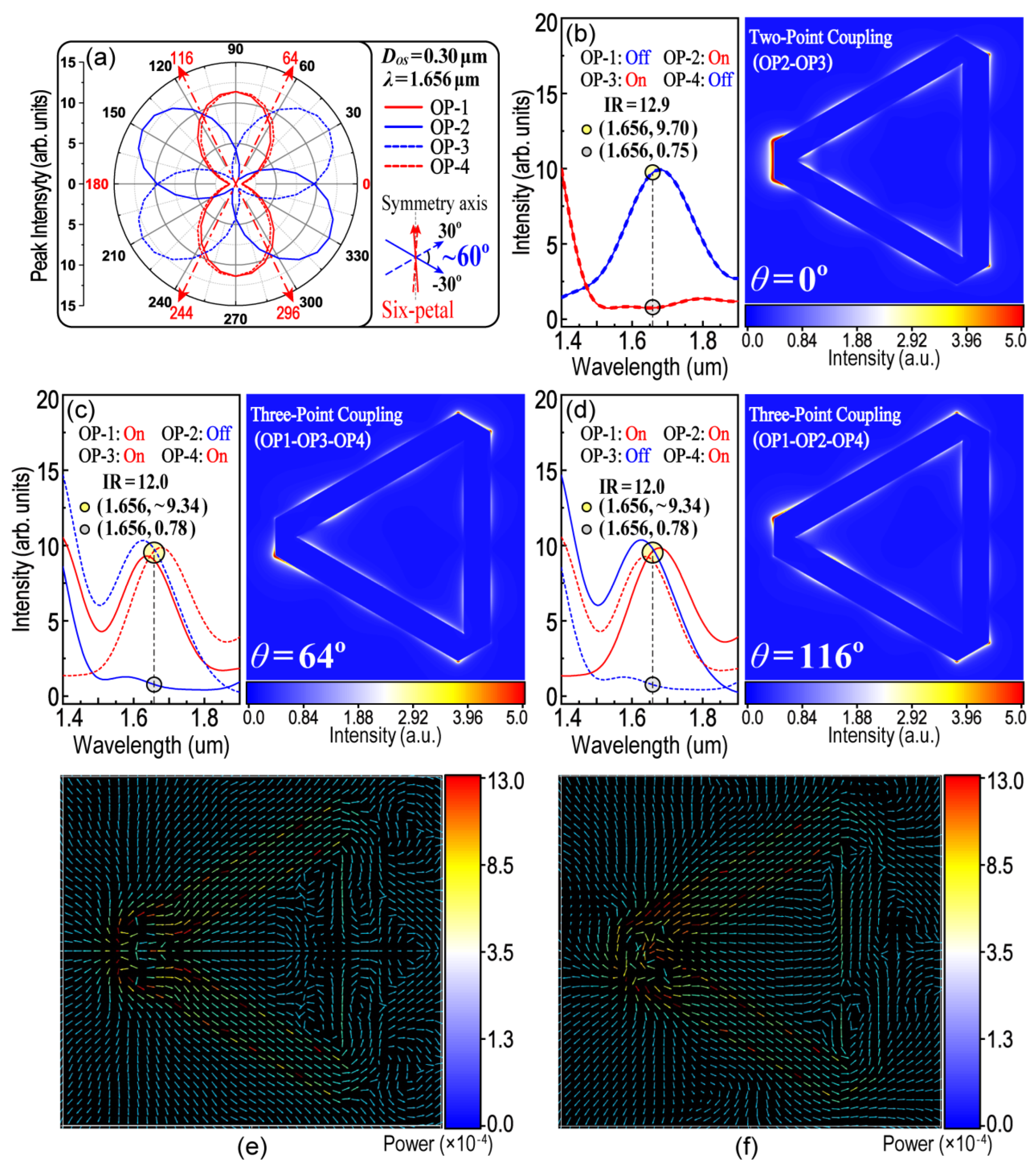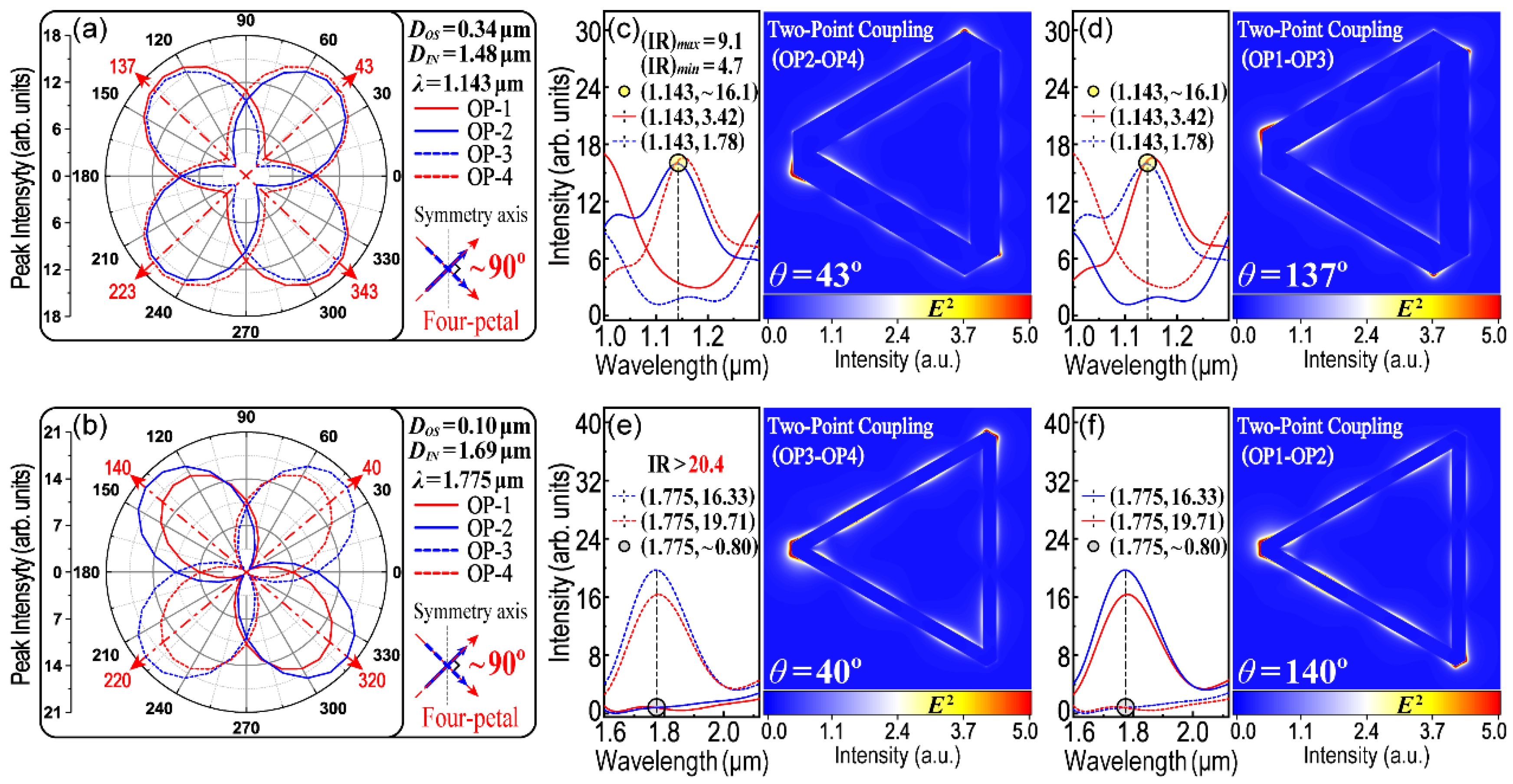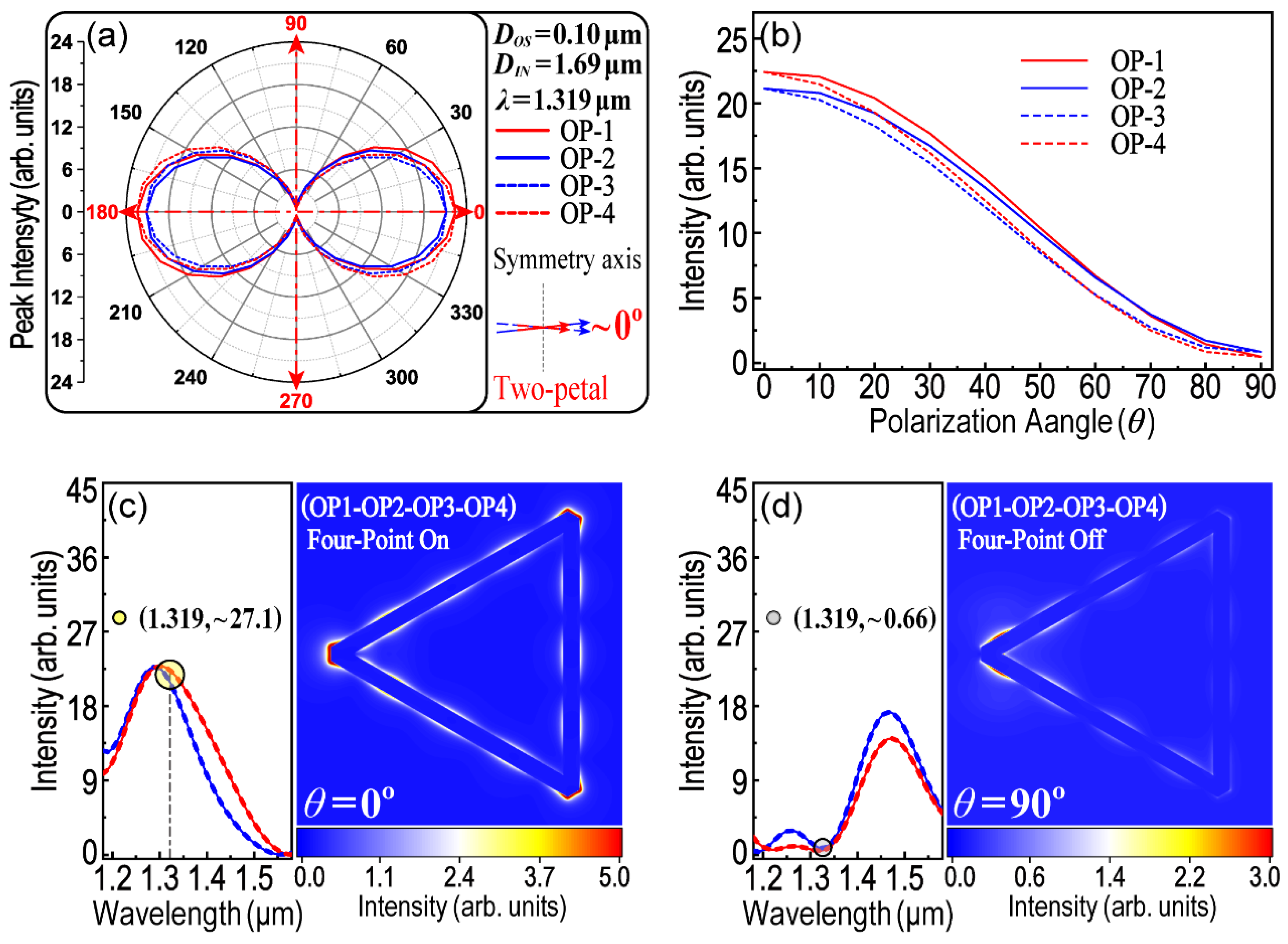1. Introduction
Surface plasmons (SPs) are the collective oscillation of free electrons which can simultaneously generate evanescent waves propagated along the metal surface [
1,
2]. When they are excited by light, SPs will be converted into surface plasmon polaritons (SPPs) and are able to be controlled and localized within a special metallic nanostructure in those certain regions such as the tips, the edges or the gaps [
3,
4,
5,
6]. The localized surface plasmon (LSP) and LSPR can effectively enhance the localized electromagnetic field (LEF), which is thought to be a novel technique that possesses potential applications in many fields such as SERS, SERS sensors, plasmon-mediated chemical reactions and so on [
4,
7,
8,
9,
10].
Traditionally, however, the excitation of LSPR as well as the subsequent detection of LSPR scattering share one and the same light channel. As we know, the spectrum of LSPR scattering (or SERS) generally contains abundant and important information [
11]. For example, it could contain surface morphology and symmetry information of an LSPR structure itself, and it could also contain the bonding and polarization information of molecules adsorbed on that LSPR structure. The conventional method referred to above is not the best way to excite LSPR or SERS because it will eventually force us to obtain a compounded signal with the background noise of the incident light [
12]. This becomes a great obstacle for the application of SERS especially in some special circumstances such as in the biosensing of living cells or in analyzing the polarization characteristics of specific molecules [
13,
14].
For this reason, a potential alternative method was reported that could remotely excite LSPR and SERS. The method is based on the interactions between LSP and propagated surface plasmon polaritons (which could be named as LSP-PSPP coupling) [
15,
16] and then the SERS excitation and SERS detection could be worked on two individual paths, which make it possible to obtain a relatively independent and pure scattering spectrum without the interference of the incident light. For example, a SERS remote-excitation device based on silver nanowires (AgNWs) was successfully applied as endoscopic probes for the SERS biosensing of live HeLa cells [
13]. The device was able to obtain SERS signals inside of HeLa cells simultaneously without excessive exposure to the SERS exciting laser. The applications for the remote excitation of SERS could also be found in surface catalytic reactions [
17], LSPR manipulations [
18], remote entanglement of quantum emitters [
12], etc. However, the studies introduced above were mainly concentrated on AgNW and AgNW-based systems (for example, a silver nanoparticle-nanowire junction [
12,
13], branched AgNW dimer [
18], etc.). Could this phenomenon be observed in other systems? If so, could we find some new phenomena or potentially interesting applications in those new systems?
Most recently, Chen et al. reported a simple two-step approach [
4,
19,
20,
21], which could synthesize two-dimensional HGNSs, as shown in
Figure 1d–h. HGNS could grow epitaxially from a solid gold nanosheet (SGNS, as shown in
Figure 1a–c and
Figure S1a–c) in the liquid phase, and it commonly contains a regular or irregular hollow cavity formed concentrically in the center of itself (see
Figure 1d–h). The shapes for the center cavity and the outer solid sheet could be either homotype or heterotype (see
Figure 1d–h) [
20,
21]. In fact, there are more heterotype HGNSs among the reaction outcomes (
Figure 1e–h). The outline of these HGNSs is normally hexagonal, including two types: regular hexagon or irregular hexagon. The irregular hexagon has three long sides and three short sides cross-linked alternatively. If it is combined with a triangle cavity in the center, a H–T heterotype HGNS is then achieved (as shown in the sketch maps in
Figure 1i–k). In this paper, the studies are focused on the polarization-dependent anisotropic properties of those H–T heterotype HGNSs, because, compared with T–T homotype HGNSs, the symmetry of the structure has been destroyed one step further. This breaking of the symmetry is of great benefit to enhance the optical anisotropic properties of HGNSs, and the latter (optical anisotropy) is the foundation for HGNSs to be utilized as polarization-dependent waveguide switches [
21]. Therefore, the remote excitation and controlling of SPPs and LSPR among four coupled hotspots (i.e., the four remote vertexes of the outer hexagon) were systematically evaluated using FDTD simulations.
3. Results and Discussion
In a given metallic nanostructure, the LSPR and resonance wavelength are dependent on many factors such as the structure size, symmetry, surface morphology, etc. Among these factors, the structure symmetry is sensitive to the polarization of the exciting light. Therefore, in order to clarify the interactions between the structure symmetry and exciting light polarization and also to clarify how these interactions affect the remote-excited SPPs and LSPR, the polarization-dependent LSPR spectra of H–T HGNS were firstly and systematically calculated. The size of
DOS varies from 0.02 μm to 0.70 μm, whereas the total length of six sides of the outer hexagon is kept constant to 6.0 μm. Thus,
DOL will vary along with the variation in
DOS. Except for a few special cases, the size of the center triangle is also kept unchanged (
DIN = 1.55 μm). It must be pointed out that in order to obtain desirable results in some special cases, we sometimes need to optimize some parameters appropriately. In these cases,
DIN is slightly adjusted according to the practical requirements.
Figure 2 and
Figure 3 are the polarization-dependent LSPR spectra obtained from OP1, while
DOS is within the range of 0.02–0.34 μm and 0.38–0.70 μm, respectively. The spectra are convenient for us to trace the position of each LSPR peak and its dependence on
θOP-i as well as
DOS. When
DOS is smaller than 0.22 μm, four obvious LSPR peaks could be observed around the wavelength of 0.95, 1.10, 1.30 and 1.70 μm, respectively. With the increase in
DOS, the variation in the LSPR peak position is not simply red-shift or blue-shift, because some of the main LSPR peaks will be split into more subpeaks, or conversely, some subpeaks will also be able to merge into one main peak. For example, the peak-splitting begins when
DOS is larger than 0.22 μm for the LSPR peak around the wavelength of 1.30 μm (see
Figure 2e–g and
Figure S2a–c). When
DOS reaches 0.26 μm, the LSPR peak initially around 1.30 μm has been split into two subpeaks, of which one is centered at 1.172 μm and the other is centered at 1.347 μm (see
Figure 2g and
Figure S2c). On the contrary, when
DOS increases from 0.26 to 0.46 μm, two LSPR subpeaks, which are around 0.913 and 1.042 μm, respectively, will be merged into one peak firstly, and then split apart again (see
Figure 2g–i and
Figure 3a–c). Therefore, it is difficult to judge the shift of these LSPR peaks when
DOS is just varied within this range (0.26–0.46 μm). The result is not surprising, because although the length of
DOS is increased, the total length of the outer hexagon (6.0 μm) has not been changed, which means that
DOL will be subsequently decreased.
Interestingly, however, there is an LSPR peak (varied within 1.626–1.719 μm) that has neither peak-splitting nor peak-merging, and it will simply shift to a shorter wavelength with the increase in
DOS in the whole range. In fact, the optical properties of an H–T HGNS can be resolved as the superposing and coupling of several T–T HGNSs.
Figure S3 is a simple graph which illustrates four types of these resolved T–T HGNSs (as shown in
Figure S3a–d respectively) and their variations with the increase in
DOS. It can be inferred from
Figure S3 that the value of
DOS determines the size, the type (e.g., if it is an equilateral, isosceles or scalene triangle?) and the spatial orientation of the red triangle (as drawn by the red-dashed line in
Figure S3). Consequently, that is the reason why the LSPR characteristics will be, finally, determined by
DOS. Among all T–T HGNSs, the type four, which is marked by a blue and dashed-rounded rectangle, is comparatively special and different. It is composed of two equilateral triangles no matter if the size of
DOS is large or small. When
DOS increases, the side length of the red-dashed triangle (type four) decreases monotonically (see the calculation in
Figure S4b). That might explain why only the blue-shift of the LSPR peak (varied from 1.719 μm to 1.626 μm) was observed with the increase in
DOS. If
DOS is increased to 0.24 μm, it is a critical state. If
DOS is smaller than this value, the blue solid-line triangle is still fully confined within the red dashed-line triangle, or if not, three corners of the blue solid-line triangle will appear at the outside of the red dashed-line triangle. That might be the reason why some LSPR peaks (e.g., the peak around 1.30 μm) begin to split when
DOS reaches 0.24 μm (see
Figure 2 and
Figure S2).
In addition, the difference in the spatial orientation between two cooperated triangles (e.g., red dashed-line and blue solid-line triangle in
Figure S3) will also be changed monotonically along with the increase in
DOS (see
Figure S4c). These changes in spatial orientation will be reflected in their polarization-dependent LSPR scattering spectra.
Figure 4 provides a series of polar plots of the peak intensity as a function of
θOP-1 in the wavelength range from 1.628 to 1.712 μm. The symbol of
(λ)θOP-i(max) is used to represent the polarization angle of the incident-excited light with regard to the counterpart LSPR maximum. Thus,
(λ)θOP-i(max) is a special
θOP-i, with which the excited LEF obtains its maximum value because of LSPR. In the symbol of
(λ)θOP-i(max), the left subscript “
λ” represents the concerned LSPR wavelength, whereas the right subscript “OP-i” represents where the signals are collected (e.g., OP1–OP4), and the symbol “
max” indicates that the data recorded are at a polarization angle (
θ) when the strongest LEF is obtained.
Figure 4 clearly demonstrates the
(λ)θOP-i(max) and its shift tendency with the corresponding LSPR peak when
DOS increases from 0.06 to 0.50 μm. The
(λ)θOP-1(max) varies within a broad range from 140° to 60° (see
Figure 4a–l) and the LSPR peak position moved from 1.712 to 1.628 μm monotonically (see
Figure 4m). Similar results can be found in
Figure 5,
Figures S5 and S6 for the LSPR peaks around 1.10, 1.30 and 2.10 μm, respectively. The differences are mainly regarding how many degrees
(λ)θOP-1(max) will be rotated over and which direction the LSPR peak will move toward with the increase in
DOS. For example, as shown in
Figure 5,
(λ)θOP-1(max) for the LSPR peak near 1.30 μm only varies within a very narrow range (from 10° to 30°). The corresponding LSPR wavelength moves from 1.295 to 1.358 μm, the direction of which is just opposite to that in
Figure 4. The polarization of the LSPR peak around 1.10 μm will be affected by peak-splitting when
DOS is larger than 0.26 μm. Moreover, as for the LSPR peak around 2.10 μm, LSPR is only manifest when
DOS is larger than 0.38 μm (as shown in
Figure 2,
Figure 3,
Figures S5 and S6).
In conclusion, as we mentioned at the beginning, the optical properties of an H–T HGNS can be resolved as the superposing and coupling of several T–T HGNSs. With the variation in
DOS, the structure and symmetry of the resolved T–T HGNSs (as shown in
Figure 4 and
Figure S3) will thus be modified accordingly. The optical properties, including the propagation and interaction of SPPs, the remote excitation of the LSPR and the polarization characteristics, are closely connected with these two factors (i.e., the structure size and its symmetry). The polarization-dependent LSPR spectra calculated using the FDTD method are able to reflect the details of these influences and interactions. Then, the polar plot of the LSPR peak intensity, which is further extracted from those polarization-dependent LSPR spectra, is the basis for our following research on the remote-controlling of LSPR coupling among four objective OPs.
In the above discussions, the main problems are how the polarization of the incident light affects the remote-excited LSPR at one hotspot (e.g., at OP1). As we know, LSPs could interact with PSPPs to form an LSP–PSPP interaction. Then, the LSPR at different hotspots (e.g., four OPs) could be controlled because of those LSP–PSPP interactions. Therefore, in order to investigate the remote-controlling of the LSPR at different OPs, the remote-excited and polarization-dependent LSPR spectra at OP2 were calculated and compared with that calculated at OP1.
Figure 6 displays the compared results for
DOS = 0.26 μm,
DOS = 0.30 μm and
DOS = 0.34 μm, respectively. The results indicate that there is no significant difference between OP1 and OP2 in the position of their corresponding LSPR peaks (the difference is less than 15 nm as compared with
Figure 6a–f). However, the difference has a trend to be enlarged with the increase in
DOS. The difference is also relevant to the LSPR wavelength (the shorter the wavelength is, the bigger the difference will be).
Figure 6 also displays a comparison between
(λ)θOP-1(max) and
(λ)θOP-2(max) with respect to the corresponding LSPR peaks. Although there is little difference in the LSPR peak position,
(λ)θOP-1(max) and
(λ)θOP-2(max) are quite different and their difference will also be enlarged with the increase in
DOS. The anisotropy of
(λ)θOP-i(max) among those asymmetric OPs at the same LSPR wavelength means that H–T HGNS have a promising potential to be applied in the remote-controlling of LSPR or SERS, remote-controllable waveguide switches or interactions and so on. Notably, two interesting and useful results were found which are highlighted in yellow in
Figure 6. They share two common features.
First, one of
(λ)θOP-i(max) is equal to 90°, which means that considering the structure symmetry, as for two symmetrical OPs, the polar plot of the peak intensity as a function of
θOP-i will be almost overlapped. For example, OP1 and OP4 (also OP2 and OP3) are symmetrical with respect to the
x-axis (see
Figure 1j). With respect to the same axis, the polar plot for
θOP-1 will be symmetrical to that of
θOP-4 as well. Thus, when
(λ)θOP-i(max) is equal to 90°, the polarization curves in the polar plot for two corresponding and symmetric OPs will be overlapped and their polarization properties will be mirrored with the
x-axis. There are two polarization angles equal to 90°, respectively, in
Figure 6d,g. The first one is relevant to OP2 (as shown in
Figure 6d,
DOS = 0.26 μm,
λ = 1.347 μm), while the second is relevant to OP1 (as shown in
Figure 6g,
DOS = 0.30 μm,
λ = 1.656 μm).
Second, the absolute difference of the two polarization angles is equal to 60° (
), as shown in
Figure 6d,g. This property will make it possible to obtain a six-petal patterned polar plot for OP1–OP4 and then divide 360° into six equal parts (as shown in
Figure 7a). This six-petal polar plot could help us to pick out the required polarization angle (
θ), with which the LSPR and interactions among three OPs (e.g., three-point coupling, as shown in
Figure 7c,d) could be remotely excited and controlled using only one polarized exciting laser.
Based on the above discussions, there are three important parameters that should be firstly ascertained. They are the polarization angle (
θ) of the incident light, the resonance wavelength (
λ) that has appropriate polarity with respect to
θOP-i (i = 1, 2, 3, 4) and the corresponding
DOS for the above
θ and
λ.
Figure 6 has provided two groups of these parameters that can be used directly and require no further optimization. The first is when
λ = 1.347 μm and
DOS = 0.26 μm.
Figure 7a shows a six-petal polar plot for the peak intensity at
λ = 1.347 μm as a function of
θOP-i (i = 1, 2, 3, 4), from which the parameter of
θ for the three-point coupling of the LSPR could thus be determined. As shown in
Figure 7b–d, the incident-excited light with three polarization angles (
θ = 0°, 59° and 121°) was chosen, with which two-point and three-point coupling of the LSPR could be remote-controlled. When
θ = 0°, LSPR only occurs at OP1 and OP4 (two-point coupling). When
θ = 59° (or
θ = 121°), LSPR occurs at three points of OP1, OP2 and OP3 (or OP2, OP3 and OP4, three-point coupling), respectively. The intensity ratio (IR) is defined to compare the LEF intensity at different OPs. The higher IR value means the better performance in optical anisotropy. For example, in
Figure 8c,d, the IR is equal to 8.4 which means the intensity of the LEF at the “hotspots” is 8.4 times higher than that at the “cold spots”. The results indicate that the on-off switching of the LSPR could be controlled using a remote technique. The following work, then, is to screen out more and appropriate groups of parameters so as to cover all modes of the control logic. For example, the second group of the practical parameters could be derived from
Figure 6i, while
λ = 1.656 μm and
DOS = 0.30 μm, as shown in
Figure 8. The results of
Figure 8 are symmetrical and complementary with those of
Figure 7. Here, two-point coupling is transferred to OP2 and OP3, and three-point coupling is transferred to OP1, OP3 and OP4 (or OP1, OP2 and OP4), accordingly. All modes, which control the LSPR communicated in three out of four OPs, are completely included because there are only four modes in three-point coupling (i.e., OP1–OP2–OP3, OP1–OP2–OP4, OP1–OP3–OP4 and OP2–OP3–OP4).
Figure 8e,f display the mapping of Poynting vectors when
θ = 0° and
θ = 64°, respectively. It could help to analyze the flow of electromagnetic power and the transmission of SPPs.
Theoretically, there are six modes in two-point coupling; however,
Figure 7 and
Figure 8 only display two of them.
Figure 9 displays a polar plot which owns four petals, and every two adjacent petals are almost vertical. This property makes it possible to control the LSPR which occurred simultaneously at two out of the four OPs and fill in the blank for those modes of two-point coupling. In order to obtain the desirable results, the parameters in
Figure 9a are optimized from
Figure 2i and
Figure 6i, while
λ = 1.143 μm and
DOS = 0.34 μm but the size of
DIN is slightly modified from the initial
DIN = 1.55 μm to
DIN = 1.48 μm. When the polarization angle is 43° (or 137°), LSPR could occur simultaneously in OP2–OP4 (or OP1–OP3). Furthermore, the last two modes for two-point coupling (OP3–OP4 and OP1–OP2) can be found in
Figure 9e–f. This group of parameters is
λ = 1.775 μm,
DOS = 0.10 μm and
DIN = 1.69 μm. Therefore, in addition to three-point coupling, all modes for two-point coupling are also completely identified in the H–T HGNS.
Finally, a two-petal patterned polar plot was achieved while
λ = 1.319 μm,
DOS = 0.10 μm and
DIN = 1.69 μm. As shown in
Figure 10, the main feature of this two-petal plot is that four curves for all OPs are almost overlapped. Thus, the intensity of the LEF at OP1–OP4 is almost equivalent no matter how many degrees the polarization angle (
θ) is.
Figure 10b shows the dependence between the LEF intensity and incident polarization (
θ). The result means that the LEF intensity at four OPs could be controlled and regulated at the same time by tuning
θ. When
θ = 0°, the LEF intensity obtains its maximum value and LSPR turns on simultaneously at all OPs (as shown in
Figure 10c). However, when
θ = 90°, four-point on-off switching of LSPR was then obtained (see
Figure 10d). Therefore, in addition to two-point coupling and three-point coupling, a group of parameters is now discovered which is suitable for four-point on/off switching of LSPR.
It must be pointed out that the parameters displayed in the main text for each situation are not the only ones. Take two-point coupling; for example,
Figure S7 shows more groups of parameters which are also suitable for two-point coupling. Under the different conditions, the calculated value of the IR is also different. Thus, if we want to obtain an ideal two-point coupling, three basic features of its polar plot must be satisfied simultaneously. First, as for two-point coupling, four-petal or a quasi-four-petal patterned polar plot is required. Commonly, the polar plot should have eight petals because they are the polarization-dependent characteristics for four points. Under given conditions, the polarization curve for some OPs will be overlapped or enclosed within those for other OPs. A four-petal polar plot is a fit for two-point coupling because there are only four polarized directions, and each direction contains two petals (overlapped or partially overlapped). Second, every two adjacent polarized directions are best to be perpendicular to each other. Third, the minimum value of the polarization curve in the polar plot should be as small as possible. The polar plot in
Figure 9a well satisfies the first and second conditions, but does not satisfy the last one. The value of the IR at some OPs is too small (e.g., the minimum IR is only 4.7 in
Figure 9c) and the result is thus not ideal. Finally,
Figure S8 displays three groups of parameters which are able to switch on/off the LSPR only at one OP. As mentioned above, the difference in the LSPR wavelength between OP1 and OP2 (or OP3 and OP4) has a trend to be enlarged with the increase in
DOS. Therefore, it exists as a probability while the position of the LSPR peak for OP1 is just overlapped with the valley for OP2 (as shown in
Figure S8a). In this case, although it is still a four-petal polar plot, it is not a fit for two-point coupling but is useful for one-point switching.
